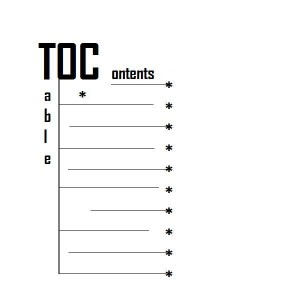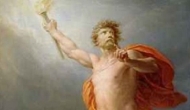 A new database of information is rising up to compete with Wikipedia. And it may just change all of our lives – or what we think of as our lives.
A new database of information is rising up to compete with Wikipedia. And it may just change all of our lives – or what we think of as our lives.
While Wikipedia has become the leading source of information on the web, maintained and edited by a group of online volunteers, and free to the public, new rival, Table of Contents, aims to challenge Wikipedia’s dominance with a model that promises not only quick and easy access to information, but also provides a progressive learning experience for the mind, body, and soul.
The company is called Table of Contents (often referred to by its initials TOC and pronounced “tock” as in tick-tock) and they believe that they are poised to challenge not only how information is organized and disseminated around the globe, but how we as individuals think and see the fabric of reality.
Gordon Osgood Doggett is the visionary behind Table of Contents and he is an unusual man in virtually every respect. Standing nearly 8’ feet tall, and weighing 400 pounds of thoroughly sculpted muscle, Doggett was a four time All American wrestling champion at Cornell University, achieving a perfect record of 65-0.
Genetically fated for near gigantism, his hands are so large that he could not use a traditional computer keyboard in college, relying instead on auditory conversion software in conjunction with a custom made keyboard with extra large keys, to accommodate his kielbasa-like digits.
While completing his first PhD at the Massachusetts Institute of Technology, Doggett became increasingly unsatisfied. The voice recognition software was clunky and made multiple errors no matter how many tutoring sessions he completed, reading passages from great novels and technical manuals to train the software to recognize the specific pattern of his voice. The oversize keyboard was large and cumbersome, keeping him chained to his desk, more or less. This inconvenience lead Doggett to develop Thinker, his first business venture, and the first company to specialize in thought to text software, instantly converting your thoughts to error free text from a small remote transmitter installed on crown of the head beneath the scalp, and featuring all the functionality of typical document software, with multiple submenus that can all be operated with the whim of the mind. Doggett sold the company to Wurst Industries in the summer of 2001 for 165 million dollars when he was only 28 years old.
While erning his second PhD in computer engineering at the University of Maryland, Doggett began a religious quest, a shamanic exploration of the outer reaches of the mind. During one libertine session of near divine excess, in 2004, Doggett ingested 100,000 micrograms of LSD in one sitting, resulting in a complete mental collapse that left him in a state of catatonia for three months in which he was unable to even blink, requiring the installation of a special device that watered his eyes with fresh saline solution every 83 seconds. In was during this period, staring up the hospital’s fluorescent ceiling lights, that Doggett claims lead to the invention of Table of Contents and its unprecedented code that is on par with the complexity of the universe itself.
Dr. Albert Grange, senior researcher at Applied Compute, one of the leading code development centers in the world, says of Doggett, “The math behind the code is like a curtain separating us from the thoughts of God. We are working 24 hours a day to pull that curtain back and take a look.”
Says Doggett, “After my LSD experience, I appeared catatonic to the rest of the world, but internally I was on a great journey through numerous layers and thresholds of the universe, going beyond the boundaries of atomic substructures into a layered arrangement of multiple infinite universes.”
While this statement would seem to indicate a newly acquired enthusiasm for an escalating series of possibilities, Doggett sees it another way, rather as an infinite series of finite ends.
“What I learned during my experience is that there are no tense structures, nothing has happened, or will happen or is happening, other than to say that all three conditions are happening at once. Everything is. All possibilities have been accounted for in the genesis of the universe. Every conceivable permutation of events. You think of a thread line of action beginning, intersecting with other possibilities, every event existing in the cascading wave of the events that preceded it. There is the illusion of choice, but choice is impossible. Your life is a preordained structure of events – on this plane – a circuit fashioned by the creator of the universe.”
Where Doggett’s theories become more complex in his discussion of planer realities, perhaps best exemplified by TOC logo, a kind of Pachinko game, a chandelier of lines each broken at some non-uniform point, allowing access to the next tier, what he refers to as “Track-shifting.”
“On every planer reality, everything that can occur is already in place. Or else it couldn’t occur. What seems like choice does not operate in the plane you are on. All you can do is switch levels, switch planes. Switch tracks.”
If this is starting to sound complicated, it is. Doggett’s theories are only understood by a handful of PhD’s and astrophysicists around the world, and even then incompletely. Even by Doggett himself, since he professes not to understand the code he wrote either, transcribing it in something like a trance, perhaps the way Samuel Taylor Coleridge composed Rhyme of the Ancient Mariner, acting as a conduit to an unseen voice whispering in his ear.
Says Dr. Chen Lee of Standford, “In the nine months since Dog presented his ideas, we’ve begun to discover the workable models for the math. It’s absolutely astonishing. But we have a long way to go. Fortunately Dog is a good communicator, and able to translate his mathematical ideas into analogies that are slightly easier to understand.”
In one of these analogies, Doggett provides an example of a man dying from a terminal disease in the hospital.
“The man is in the hospital bed, dying from the disease. He is surrounded by his wife and children. And then the moment comes as death takes him, and his eyes are closing and then…A doctor rushes into the room and says ‘We’ve found a miracle serum that will cure you.’ And the man is injected with the serum and in a matter of moments is restored to complete health. He rises from his bed, alive with renewed purpose. He hugs his family and they wall walk out of the room together.”
Doggett continues, “For every person, existence is permanent. There is no death. Only ongoing participation as a circuit in a complex machine. However in another universe, another track, another combination of circumstances and possible outcomes, in this other universe the family watches as the man dies. They experience the pain of loss, and they move on in their own ongoing existence.”
When extrapolated to its furthest ends, Doggett means to say that in an infinite series of parallel universes, you are both alive and dead in an infinite series of alternate realities, a paradigm reminiscent of Schrodinger’s Cat, whereby the cat is both dead and alive at the same time.
Says Doggett, “Wikipedia has been a great resource for humanity and I would never dream of deriding it in any way. But Table of Contents represents a next generation database, because TOC not only includes everything there has ever been but everything there has not.”
When pressed further on this, Doggett stares at me for a moment with the tender look of a father to his son.
“From the beginning to the end including the middle, every topic of every subject from before to after, completely, totally, comprehensive table of contents of everything that has ever happened or will happen including everything that has not happened nor ever will,” he says.
Quite a mouthful for sure. But if you say it ten times, it starts to make some sense.
To show you a pragmatic example, for instance, a search for John Wilkes Booth on TOC reveals an entry about the assassin of the 16th president of the United Sates, Abraham Lincoln. TOC also includes a parallel listing for John Wilkes Booth the 2nd, who attempts to assassinate the president in the 25th dimension and fails. TOC also includes another 23,000 entries, which are constantly being updated, of John Wilkes Booth alternate scenarios that occur in alternate dimensions where different circumstances have conspired to create different eventualities on their planer tracks. In all of these tracks the sequence of events is fixed. No choices, no decisions that in any way that effects the outcome. Choice is an illusion in the participant’s eyes.
Dr. Chen Lee again says, “The idea that you can list something that will never come into existence is a paradox, of course. By making such a listing, the very thing that is not in existence comes into existence by virtue of being listed. This creates some interesting distortions in the fabric of reality. Things are becoming real and not real at the same time as they interconnect with infinite realities.”
So how does it work?
The answer as best as can be explained to the layman is that Doggett’s powerful code pulls data from across tracks within the space time continuum accessing information for as yet undefined realities.
Doggett says, “Switching tracks involves a transmission of conscious. It can occur through drugs, mysticism, meditation, pain, love, force of will and probably an infinite number of other ways. Our software is able to operate beyond the speed of light, accessing multiple realities that are perpetually evolving, expanding and contracting in order to categorize them all in an easy to use thought controlled database.”
If this all sounds crazy, it might very well be.
But with an initial angel investment of 1 billion dollars from Wurst Industries, marking the second time the two have partnered, is any indication, TOC may very well have developed an information exchange system that might unravel the mystery of the universe.
Doggett concludes our interview leaning back in his reinforced desk chair, to rub his enormous head with his still more enormous hands, staring up at the ceiling as he might have while in a coma, dreaming of TOC, “The problem is that most people have trouble conceiving of the 25th dimension or the 300th for that matter, or the infinite number of tracks called into the existence in the moment of the Big Bang, which of course did not begin either, but simply is a preordained thought in the imagination of G.O.D.”
We’ll see, when TOC launches later this month.
Tony Shea ( Editor-in-Chief, New York)
Tony Shea is based in New York, having recently moved from Los Angeles after more than a decade on the sunny coast. His short films have won numerous awards and screened at major festivals around the world including Comic-Con. As a musician, he is the lead singer for Los Angeles rock n’ roll band Candygram For Mongo (C4M) candygramformongo.com who has been a featured artist on Clear Channel Radio’s Discover New Music Program and whose songs have been heard on Battlestar Gallactica (Syfy Channel) and Unhitched (Fox) among other shows and films.
- Web |
- More Posts (236)


![Sunset - Pelham Shore Park - Long Island Sound [PHOTOS]](https://sheamagazine.com/wp-content/plugins/special-recent-posts-pro/cache/MjAwMTAwbm9JTUdfMzM3MC1SRVNJWkU=.jpg)


![Let's Go to Chinatown, Shall We? [PHOTOS]](https://sheamagazine.com/wp-content/plugins/special-recent-posts-pro/cache/MjAwMTAwbm9jaGluYXRvd24tMi1idy0=.jpg)


![Let's Go to the Empire State Building - Shall We? [PHOTOS]](https://sheamagazine.com/wp-content/plugins/special-recent-posts-pro/cache/MjAwMTAwbm9JTUdfMzkxNjE=.jpg)



![Scenes from Washington Square Park - NYC [PHOTOS]](https://sheamagazine.com/wp-content/plugins/special-recent-posts-pro/cache/MjAwMTAwbm9JTUdfNDA1Mg==.jpg)




